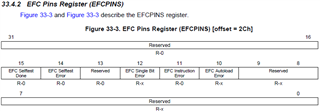I understand that all Group3 errors result in an abort but my question is how should this be handled by the code: in more detail:
- Specific case: eFuse autoload error, Group 3 Chan 1:
What abort handler is called from the ".intvecs" vector table? The TRM (SPNU515C) provides the following example of the vector table but the two highlighted abort handlers don't sound appropriate for this particular error.
- General case: same question for ECC related Group 3 errors.
Marcus



